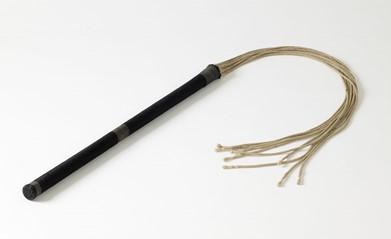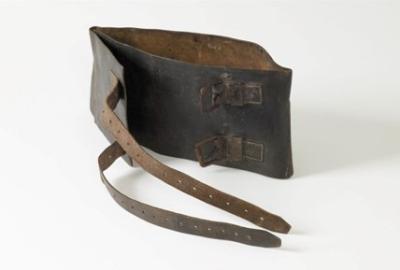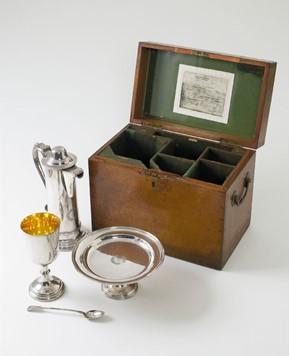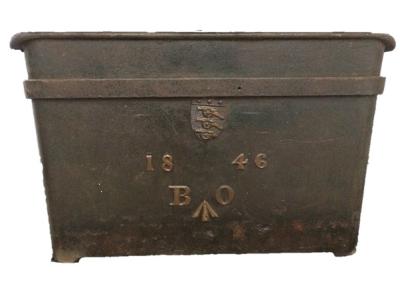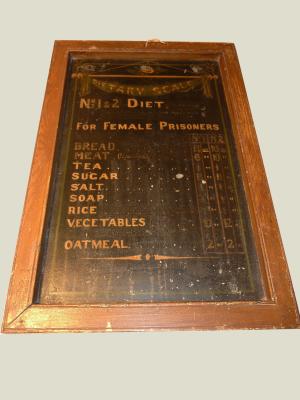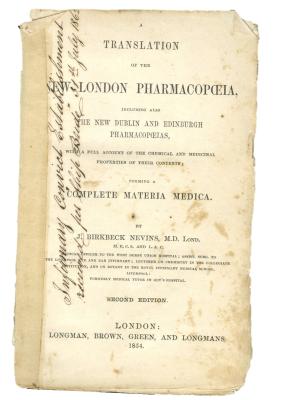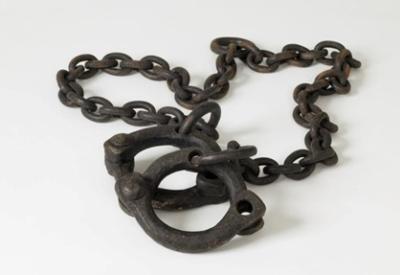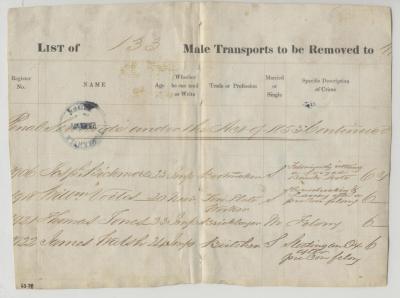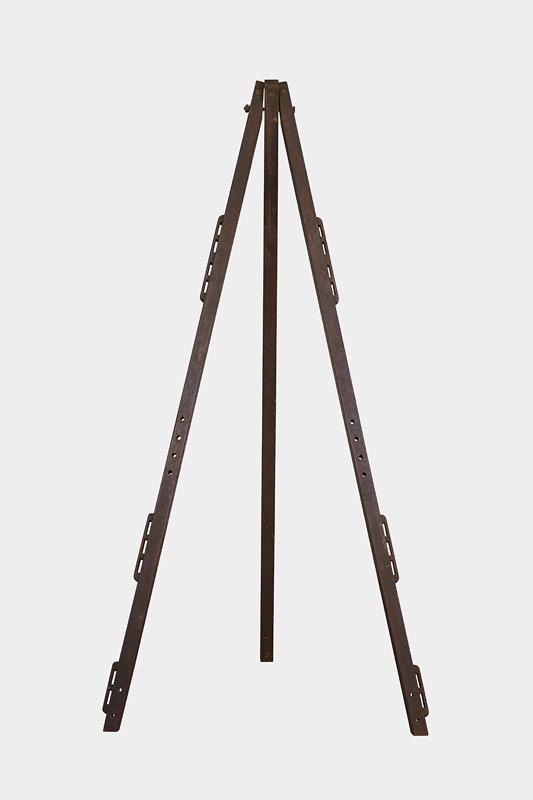FLOGGING TRIANGLE
1850 - 1943Tall, thin, wooden, flogging triangle. Consisting of three, long, thin, rectangular beams of timber, each measuring H2740 x W75 x D60mm. The beams are rounded at the top, and squared at an angle at the bottom, allowing them to sit flat against the floor when the triangle is opened out. All three beams are pivoted at the top by a metal bolt and nut to form three legs that can be opened out to form a standing tripod, with two legs at the side and one at the rear. The two side legs have three separate wooden cleats screwed to their outer sides, each containing four, three and two rungs respectively, through which ropes or other bonds may be threaded and secured. Both side legs also hold four equally spaced holes of 15mm diameter, occurring about one third of the way up from ground level (possibly for securing other attachments such as body restraints etc). A metal cleat, for securing rope and bonds, is attached to the central rear leg about one third of the way up from ground level.
The flogging triangle can be provenanced directly to Fremantle Prison, though it is unknown where or how it was kept while not in use.
Details
Details
Flogging was a form of corporal punishment inflicted upon convicts, and later prisoners, at Fremantle Prison. Prisoners could be sentenced to flogging as punishment for acts committed whilst inside prison, such as for insubordination or misbehaviour, or alternatively flogging could be part of a prisoner’s original sentence.
In the 1850s and 1860s it was not uncommon for prisoners at the Convict Establishment to be sentenced to flogging, with the maximum of 100 lashes for breaches of discipline. The most serious offence, for which this type of punishment could be inflicted, was attempting to escape from legal custody.
This flogging triangle was used as a way of securing prisoners during this form of punishment. The triangle’s beams were rounded at the top, and squared at an angle at the bottom, allowing them to sit flat when the triangle was opened out. The whole triangle is pivoted at the top by a metal bolt and nut to form three legs that can be opened out to form a standing tripod, with two legs at the side and one at the rear. The two side legs had three separate wooden cleats screwed to their outer sides, each containing four, three and two rungs respectively, through which ropes or other bonds may be threaded and secured. A metal cleat is also attached to the centre rear leg, about one third of the way up from the ground, also for securing bonds.
Once strapped to the flogging post, the prisoner received punishment in the form of flogging or birching. Flogging was undertaken with the cat-of-nine tails, a whip with nine knotted strands or cords, whilst birching used a bundle of long birch twigs bound together by a cord. In order to receive the punishment, the prisoner’s back was bared, though he was made to wear a wide leather belt secured around his upper waist to protect his kidneys from damage, and a smaller leather strap around his neck to protect his arteries. After the lashes were administered, salt or brine would be applied to the wounds to cleanse them and help them heal.
The flagellator was often a Prison Officer, sometimes specially appointed, who, for an agreed fee, was required to administer corporal punishment when necessary. Floggings were usually carried out with between six and ten Prison Officers present, together with those prisoners for whom it was thought witnessing the punishment would provide a warning and set an example. A medical officer who had the authority to stop the punishment if necessary, always attended the proceedings. However, if the punishment was stopped for medical reasons the sentence was not discharged, but rather resumed once the prisoner had healed sufficiently.
The 1940 Fremantle Prison Regulations speaks specifically to flogging as a form of punishment, stating that, “The number of strokes must not exceed twenty five and in the case of an offender under the age of eighteen must not exceed twelve, and the instrument must be either a birch rod cane, or the instrument commonly called a cat, which shall be made of leather or cord without any metallic substance woven therewith; provided that the cat shall not be used in the case of an offender under eighteen years of age.”
The last flogging in Western Australia was administered at Fremantle Prison at 9am on 21 June 1943, when a prisoner, sentenced to receive 25 lashes of the cat received 17 before the medical officer intervened. To protect his identity the flagellator was from outside the Western Australian prison system and wore a mask during the proceedings. The last birching at Fremantle Prison was carried out on 20 August 1962 when a prisoner received 12 strokes. Corporal punishment and hard labour were not officially abolished in Western Australia until the Criminal Law Amendment Act (No. 2) 1992, which came into effect from 6 January 1993.
In all likelihood this fogging triangle in the Fremantle Prison Collection is the original apparatus shipped to Fremantle from England during the 1850s, as part of the equipment required to impose discipline within the Convict Establishment.
Corporal punishment is an integral and prevalent aspect of convict history and by providing a direct link to these proceedings, this flogging triangle has high historic significance. As a representative example of the rule of life under which these convicts lived, it has high social significance and is internationally important, being attributed to the earliest period of the site, from which the Fremantle Prison receives its World Heritage Listing. It remains in excellent condition and is a rare example of the more extreme forms of punishment inflicted during the Prison’s history.
